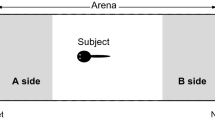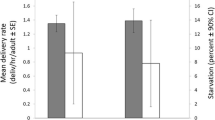Summary
We investigated kin recognition by the wood frog Rana sylvatica in blind laboratory experiments using spatial proximity as a recognition assay. Tadpoles were tested for the ability to discriminate between: 1) familiar full-sibs and unfamiliar non-kin, 2) unfamiliar paternal half-sibs and unfamiliar non-kin, and 3) familiar and unfamiliar full-sibs. Tadpoles discriminated full- and paternal half-sibs from unrelated conspecifics, but did not discriminate between familiar and unfamiliar full-sibs. Froglets from the same laboratory population were tested for the ability to discriminate between 1) familiar full-sibs and unfamiliar non-kin, and 2) unfamiliar paternal half-sibs and unfamiliar non-kin. Froglets preferentially associated with full- and half-sibs over unrelated conspecifics. Our results show that familiarity, i.e., prior association, is not necessary for kin recognition in tadpoles and froglets. The ability of tadpoles and froglets to recognize unfamiliar paternal half-sibs demonstrates that a common maternal factor is not necessary for kin recognition, and indicates that the recognition cue has a genetic component. Our results add to the increasing evidence that a variety of vertebrate and invertebrate animals have the ability to recognize unfamiliar kin by using genetically specified recognition cues.
Similar content being viewed by others
References
Arnold SJ, Wassersug RJ (1978) Differential predation on metamorphic anurans by garter snakes (Thamnophis): social behavior as a possible defense. Ecology 59:1014–1022
Berven KA (1981a) Mate choice in the wood frog, Rana sylvatica. Evolution 35:707–722
Berven KA (1981b) Altitudinal variation in development and reproduction in the wood frog, Rana sylvatica. Ph.D. Diss., Univ. of Maryland
Berven KA (1982) The genetic basis of altitudinal variation in the wood frog Rana sylvatica II. An experimental analysis of larval development. Oecologia 52:360–369
Blaustein AR, O'Hara RK (1986a) An investigation of kin recognition in red-legged frog (Rana aurora) tadpoles. J Zool (London) (A) 209:347–353
Blaustein AR, O'Hara RK (1986b) Kin recognition in tadpoles. Sci Am 254:108–116
Blaustein AR, O'Hara RK, Olson DH (1984) Kin preference behavior is present after metamorphosis in Rana cascadae frogs. Anim Behav 32:445–450
Blaustein AR, Bekoff M, Daniels TJ (1987) Kin recognition in vertebrates (excluding primates): Empirical evidence. In: Fletcher DJC, Michener CD (eds) Kin recognition in animals, John Wiley, NY, pp 287–331
Breed MD, Bennett B (1987) Kin recognition in highly eusocial insects. In: Fletcher DJC, Michener CD (eds) Kin recognition in animals, John Wiley, NY, pp 243–285
Fomanowicz DR Jr, Brodie ED Jr (1982) Relative palatabilities of members of a larval amphibian community. Copeia 1982:91–97
Hamilton WD (1964) The genetical evolution of social behavior. I, II. J Theor Biol 7:1–51
Gamboa GJ (1988) Sister, aunt-niece, and cousin recognition by social wasps. Behavior Genetics 18:409–423
Gamboa GJ, Reeve HK, Ferguson ID, Wacker TL (1986a) Nestmate recognition in social wasps: the origin acquisition of recognition odours. Anim Behav 34:685–695
Gamboa GJ, Reeve HK, Pfennig DW (1986b) The evolution and ontogeny of nestmate recognition in social wasps. Ann Rev Entomol 31:431–454
Gamboa GJ, Klahn JE, Parman AO, Ryan RE (1987) Discrimination between nestmate and non-nestmate kin by social wasps (Polistes fuscatus, Hymenoptera: Vespidae). Behav Ecol Sociobiol 21:125–128
Hews DK (1988) Alarm response in larval western toads, Bufo boreas: release of larval chemicals by a natural predator and its effect on predator capture efficiency. Anim Behav 36:125–133
Hews DK, Blaustein AR (1985) An investigation of the alarm response in Bufo boreas and Rana cascadae tadpoles. Behav Neural Biol 42:47–57
Holmes WG, Sherman PW (1982) The ontogeny of kin recognition in two species of ground squirrels. Am Zool 22:491–517
Howard RD (1980) Mating behavior and mating success in wood frogs, Rana sylvatica. Anim Behav 28:705–716
Howard RD, Kluge AG (1985) Proximate mechanisms of sexual selection in wood frogs. Evolution 39:260–277
Linsenmair KE (1987) Kin recognition in subsocial arthropods, in particular in the desert isopod Hemilepistus reaumuri. In: Fletcher DJC, Michener CD (eds) Kin recognition in animals, John Wiley, NY, pp 121–208
Michener CD, Smith BH (1987) Kin recognition in primitively eusocial insects. In: Fletcher DJC, Michener CD (eds) Kin recognition in animals, John Wiley, NY, pp 209–242
O'Hara RK, Blaustein AR (1981) An investigation of sibling recognition in Rana cascadae tadpoles. Anim Behav 29:1121–1126
O'Hara RK, Blaustein AR (1982) Kin preference in Bufo boreas tadpoles. Behav Ecol Sociobiol 11:43–49
O'Hara RK, Blaustein AR (1985) Rana cascadae tadpoles aggregate with siblings: an experimental field study. Oecologia 67:44–51
Porter RH, Matochik JA, Makin JW (1984) The role of familiarity in the development of social preferences in spiny mice. Behav Proc 9:241–254
Waldman B (1981) Sibling recognition in toad tadpoles: the role of experience. Z Tierpsychol 56:341–358
Waldman B (1982a) Sibling association among schooling toad tadpoles: field evidence and implications. Anim Behav 30:700–713
Waldman B (1982b) Adaptive significance of communal oviposition in wood frogs (Rana sylvatica). Behav Ecol Sociobiol 10:169–174
Waldman B (1984) Kin recognition and sibling association among wood frog (Rana sylvatica) tadpoles. Behav Ecol Sociobiol 14:171–180
Waldman B (1985) Olfactory basis of kin recognition in toad tadpoles. J Comp Physiol 156:565–577
Waldman B (1986) Chemical ecology of kin recognition in anuran amphibians. In: Duvall D, Muller-Schwarze D, Silverstein RM (eds) Chemical signals in vertebrates 4, Plenum Press, NY, pp 225–242
Waldman B, Adler K (1979) Toad tadpoles associate preferentially with siblings. Nature 282:611–613
Walters B (1975) Studies of interspecific predation within an amphibian community. J Herpetol 9:267–279
Wassersug RJ (1973) Aspects of social behavior in anuran larvae. In: Vial JL (ed) Evolutionary biology of the anurans, U. of Missouri Press, Columbia, pp 273–297
Wells PA (1987) Kin recognition in humans. In: Fletcher DJC, Michener CD (eds) Kin recognition in animals, John Wiley, NY, pp 395–415
Author information
Authors and Affiliations
Rights and permissions
About this article
Cite this article
Cornell, T.J., Berven, K.A. & Gamboa, G.J. Kin recognition by tadpoles and froglets of the wood frog Rana sylvatica . Oecologia 78, 312–316 (1989). https://doi.org/10.1007/BF00379103
Received:
Issue Date:
DOI: https://doi.org/10.1007/BF00379103




